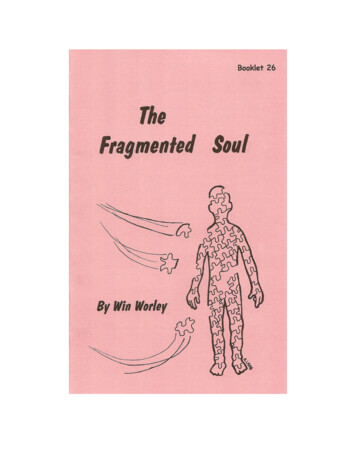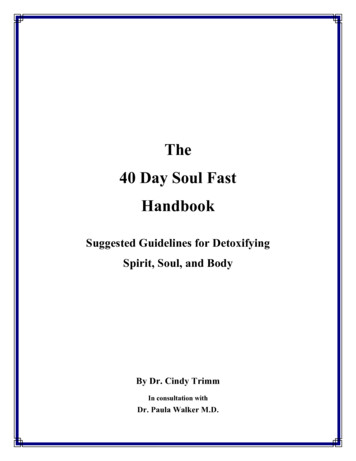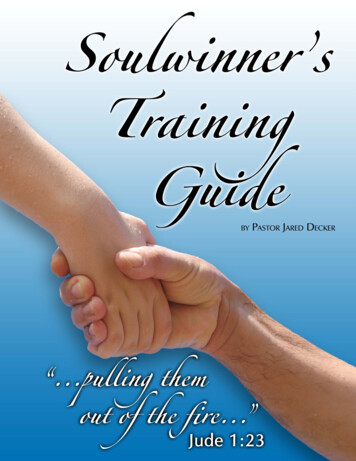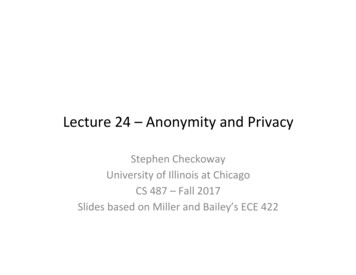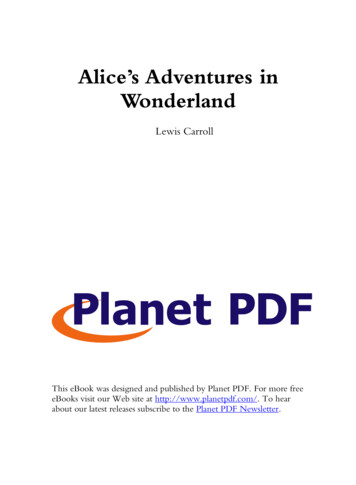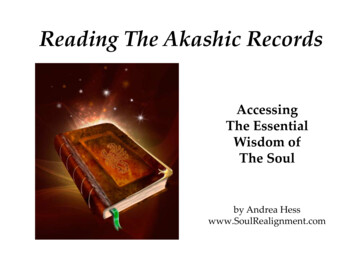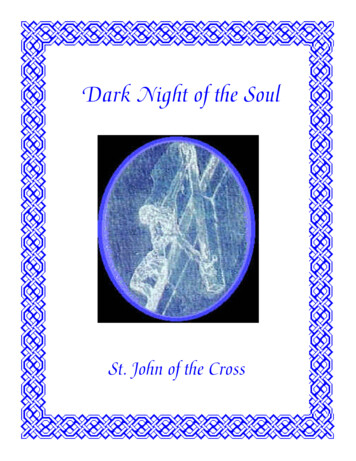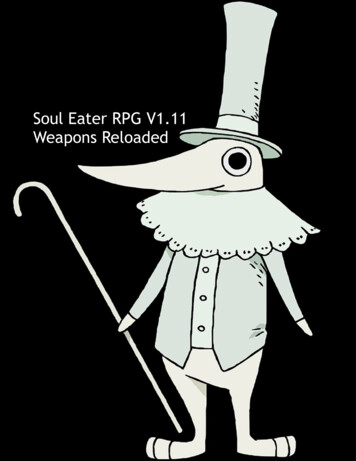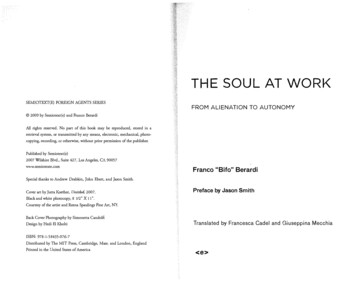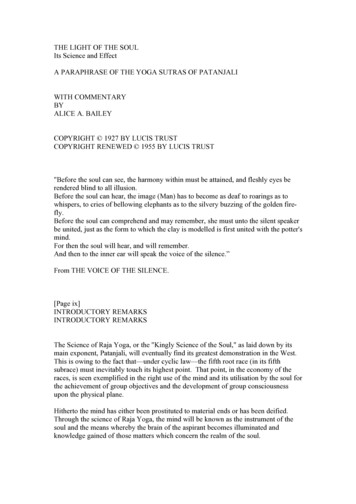
Transcription
THE LIGHT OF THE SOULIts Science and EffectA PARAPHRASE OF THE YOGA SUTRAS OF PATANJALIWITH COMMENTARYBYALICE A. BAILEYCOPYRIGHT 1927 BY LUCIS TRUSTCOPYRIGHT RENEWED 1955 BY LUCIS TRUST"Before the soul can see, the harmony within must be attained, and fleshly eyes berendered blind to all illusion.Before the soul can hear, the image (Man) has to become as deaf to roarings as towhispers, to cries of bellowing elephants as to the silvery buzzing of the golden firefly.Before the soul can comprehend and may remember, she must unto the silent speakerbe united, just as the form to which the clay is modelled is first united with the potter'smind.For then the soul will hear, and will remember.And then to the inner ear will speak the voice of the silence.”From THE VOICE OF THE SILENCE.[Page ix]INTRODUCTORY REMARKSINTRODUCTORY REMARKSThe Science of Raja Yoga, or the "Kingly Science of the Soul," as laid down by itsmain exponent, Patanjali, will eventually find its greatest demonstration in the West.This is owing to the fact that—under cyclic law—the fifth root race (in its fifthsubrace) must inevitably touch its highest point. That point, in the economy of theraces, is seen exemplified in the right use of the mind and its utilisation by the soul forthe achievement of group objectives and the development of group consciousnessupon the physical plane.Hitherto the mind has either been prostituted to material ends or has been deified.Through the science of Raja Yoga, the mind will be known as the instrument of thesoul and the means whereby the brain of the aspirant becomes illuminated andknowledge gained of those matters which concern the realm of the soul.
Under the law of evolution likewise, the mind, being the fifth principle, the fifth rootrace must be intimately concerned with it, and its corresponding fifth subrace moreintimately than any other. Students would do well to bear in mind the followingcorrespondences:1. The fifth root race2. The fifth subrace3. The fifth principle4. The fifth plane5. The fifth rayAryan.Anglo-Saxon.manas, or mind.the mental.concrete knowledge.[Page x]All the various Yogas have had their place in the unfoldment of the human being. Inthe first purely physical race, which is called the Lemurian, the Yoga at that timeimposed upon infant humanity was Hatha Yoga, the Yoga of the physical body, thatYoga which brings into conscious use and manipulation the various organs, musclesand parts of the physical frame. The problem before the adepts of that time was toteach human beings, who were then little more than animals, the purpose, significanceand use of their various organs, so that they could consciously control them, and themeaning of the symbol of the human figure. Therefore, in those early days, throughthe practice of Hatha Yoga, the human being reached the portal of initiation. At thattime the attainment of the third initiation, resulting in the transfiguration of thepersonality, was the highest initiation that man was capable of achieving.In Atlantean days, the progress of the sons of men was procured through theimposition of two Yogas. First, the Yoga which is called by the name of Laya Yoga,the Yoga of the centres which produced a stabilizing of the etheric body and of thecentres in man and the development of the astral and psychic nature. Later on, BhaktiYoga, growing out of the development of the emotional or astral body, wasincorporated with Laya Yoga and the foundation of that mysticism and devotion,which has been the underlying incentive during our particular Aryan root race, waslaid. The fourth initiation was at that time the objective. [Page xi] The subject ofthese great initiations has been discussed more at length in my previous volume,"Initiation, Human and Solar."Now, in the Aryan race, the subjugation of the mental body and the control of themind is brought about through the practice of Raja Yoga, and the fifth initiation, thatof adept, is the goal for evolving humanity. Thus, all the Yogas have had their placeand served a useful purpose and it will become apparent that any return to HathaYoga practices or those practices which deal specifically with the development of thecentres, brought about through various types of meditation practices and breathingexercises, is, from a certain aspect, a retrogression. It will be found that through thepractice of Raja Yoga, and through assuming that point of directional control which isto be found by the man who centers his consciousness in the soul, the other forms ofYoga are unnecessary, for the greater Yoga automatically includes all the lesser in itsresults, though not in its practices.When these are studied, it will become apparent why the day of opportunity has onlyjust arrived. The East has preserved rules for us since time immemorial. Here andthere orientals (with a few Western adepts) have availed themselves of those rules and
have submitted to the discipline of this exacting science. Thus has been preserved forthe race the continuity of the Secret Doctrine, of the Ageless Wisdom, and thus hasbeen gathered together the personnel of the Hierarchy of our planet. In the time of theBuddha and [Page xii] through the stimulation He produced there was a greatgathering in of Arhats. These were men who had achieved liberation through selfinitiated effort. This period, in our Aryan race, marked a climax for the East. Sincethen the tide of spiritual life has steadily flowed westward, and we may now look fora corresponding climax in the West, which will reach its zenith between the years1965 and 2025. Towards this end the adepts of the East and of the West are unitedlyworking, for they follow always the Law.This coming impulse is (as was that in the time of the Buddha) a second Ray impulse,and has no relation to any first Ray impulse, such as that which brought forth H. P.Blavatsky. First Ray impulses rise in the first quarter of each century and reach theirclimax on the physical plane during the last quarter. The interest now shown in RajaYoga and the study of this science and the rules it provides for man's unfoldment, isindicative of the general trend of this rising second Ray impulse. This interest will beincreasingly shown. Thus comes the day of opportunity.There are three books which should be in the hands of every student, the BhagavadGita, the New Testament, and the Yoga Sutras, for in these three is contained acomplete picture of the soul and its unfoldment.In the Gita we have given us (in its eighteen chapters) a description of the soul, ofKrishna, the second aspect, in his true nature as God in manifestation, culminating inthat marvellous chapter where he reveals himself to Arjuna, the aspirant, [Page xiii] asthe soul of all things, and the point of glory behind the veil of every form.In the New Testament there is depicted for us the life of a Son of God in fullmanifestation, wherein, freed from every veil, the soul in its true nature walks theearth. It becomes apparent to us, as we study the life of Christ, what it means todevelop the powers of the soul, to attain liberation, and become, in full glory, a Godwalking on earth.In the Yoga Sutras there are embodied for us the laws of that becoming, and the rules,methods, and means which—when followed—make a man "perfect even as yourFather in Heaven is perfect." Step by step there is unfolded for us a graded system ofdevelopment, leading a man from the stage of average good man, through those ofaspirant, initiate and master on to that exalted point in evolution at which the Christnow stands. John, the beloved disciple, has said that "we shall be like him, for weshall see him as he is" and the revelation of the soul to man in physical planeincarnation works ever the great transformation. Christ himself has said that "Greaterworks than I do shall ye do," holding out to us the promise of the "kingdom, thepower and the glory" provided our aspiration and endurance suffice to carry us alongthe thorny way of the Cross, and enable us to tread that path which "leads up hill allthe way" to the summit of the Mount of Transfiguration.How is this great change brought about? How does man, the victim of his desires andlower [Page xiv] nature become man, the victor, triumph over the world, the flesh andthe devil? It is brought about when the physical brain of the incarnated man becomes
aware of the self, the soul, and this conscious awareness only becomes possible whenthe true self can "reflect itself in the mindstuff." The soul is inherently freed fromobjects and stands ever in the state of isolated unity. Man, however, in incarnationhas to arrive, in his physical brain consciousness, at a realization of these two states ofbeing; he has consciously to free himself from all objects of desire and stand as aunified whole, detached and liberated from all veils, from all forms in the threeworlds. When the state of conscious being, as known by the spiritual man, becomesalso the condition of awareness of the man in physical incarnation then the goal hasbeen reached. The man is no longer what his physical body makes him, whenidentified with it, the victim of the world. He walks free, with shining face (I. Cor. 3)and the light of his countenance is shed abroad upon all he meets. No longer do hisdesires swing the flesh into activity, and no longer does his astral body subjugate himand overcome him.Through dispassion and the balancing of the pairs of opposites he has freed himselffrom the moods, feelings, longings, desires, and emotional reactions whichcharacterise the life of the average man and has arrived at the point of peace. Thedevil of pride, the personification of the misused mental nature and the distortedperceptions of the mind, are overcome and he stands liberated [Page xv] from thethree worlds. The nature of the soul, the qualities and activities inherent in the lovenature of the Son of God, and the wisdom which demonstrates when love and activity(the second and third aspects) are brought together, characterise his life on earth, andhe can say as did the Christ, "It is finished."The date of the birth of Patanjali is unknown and there is a good deal of controversyupon this matter. Most of the occidental authorities ascribe a date between the years820 B. C. to 300 B. C., though one or two place him after Christ. The Hinduauthorities themselves, however, who may be supposed to know something about thematter, ascribe a very much earlier date, even as far back as 10,000 B. C. Patanjaliwas a compiler of teaching which, up to the time of his advent, had been given orallyfor many centuries. He was the first to reduce the teaching to writing for the use ofstudents and hence he is regarded as the founder of the Raja Yoga School. Thesystem, however, has been in use since the very beginning of the Aryan race. TheYoga Sutras are the basic teaching of the Trans-Himalayan School to which many ofthe Masters of the Wisdom belong, and many students hold that the Essenes and otherschools of mystical training and thought, closely connected with the founder ofChristianity and the early Christians, are based upon the same system and that theirteachers were trained in the great Trans-Himalayan School.It should be stated here that the Sutras have [Page xvi] been dictated and paraphrasedby the Tibetan Brother and the commentary upon them has been written by myself,and subjected to revision and comment by the Tibetan. It should be noted that thetranslation is not literal, and is not an exact definition of each original Sanskrit term.It is an attempt to put into clear and understandable English the exact meaning,insofar as it is possible to do so through the medium of that nonelastic and unimaginative tongue. The student may find it of use in the study of thesesutras to compare the rendition here given, with the various other procurabletranslations.ALICE A. BAILEY.
New York, May, 1927.[Page xviii]TOPICAL OUTLINETOPICAL OUTLINEBOOK I. THE PROBLEM OF UNION.a. The higher and lower natures defined.b. The obstacles and their removal considered.c. A summation of the Raja Yoga system.Topic: The versatile psychic nature.BOOK II. THE STEPS TO UNION.a. The five hindrances and their removal.b. The eight means defined.Topic: The means of attainment.BOOK III. UNION ACHIEVED AND ITS RESULTS.a. Meditation, and its stages.b. Twenty-three results of meditation.Topic: The powers of the soul.BOOK IV. ILLUMINATION.a. Consciousness and form.b. Union or at-one-ment.Topic: Isolated unity.[Page xvii]BIBLIOGRAPHYBIBLIOGRAPHYof the translations of and commentaries uponTHE YOGA SUTRAS OF PATANJALIused in the preparation of the present work.The Yoga-Sutra of Patanjali .M. J. Dvivedi.The Yoga-Darsana.Ganganatha Jha.The Yoga Sutras of Patanjali.Charles Johnston.The Yoga Aphorisms of Patanjali.W. Q. Judge.The Yoga Sutras of Patanjali.Rama Prasada.Yoga Philosophy.Tookaram Tatya.A Compendium of Raja Yoga Philosophy, Rajaram Tookaram.Raja Yoga.Swami Vivekananda.The Yoga System of Patanjali.J. H. Woods.
BOOK I. - THE PROBLEM OF UNION[Page 1]BOOK I.THE PROBLEM OF UNIONa. The higher and lower natures defined.b. The obstacles and their removal considered.c. A summation of the Raja Yoga system.Topic: The versatile psychic nature.[Page 3]THE YOGA SUTRAS OF PATANJALI.BOOK ITHE PROBLEM OF UNION1. AUM. The following instruction concerneth the Science of Union.2. This Union (or Yoga) is achieved through the subjugation of the psychic nature,and the restraint of the chitta (or mind).3. When this has been accomplished, the Yogi knows himself as he is in reality.4. Up till now the inner man has identified himself with his forms and with theiractive modifications.5. The mind states are five, and are subject to pleasure or pain; they are painful or notpainful.6. These modifications (activities) are correct knowledge, incorrect knowledge, fancy,passivity (sleep) and memory.7. The basis of correct knowledge is correct perception, correct deduction, and correctwitness (or accurate evidence).8. Incorrect knowledge is based upon perception of the form and not upon the state ofbeing.9. Fancy rests upon images which have no real existence.10. Passivity (sleep) is based upon the quiescent state of the vrittis (or upon the nonperception of the senses.)11. Memory is the holding on to that which has been known.12. The control of these modifications of the internal organ, the mind, is to be broughtabout through tireless endeavour and through non-attachment.[Page 4]13. Tireless endeavour is the constant effort to restrain the modifications of the mind.14. When the object to be gained is sufficiently valued, and the efforts towards itsattainment are persistently followed without intermission, then the steadiness of themind (restraint of the vrittis) is secured.15. Non-attachment is freedom from longing for all objects of desire, either earthly ortraditional, either here or hereafter.16. The consummation of this non-attachment results in an exact knowledge of thespiritual man when liberated from the qualities or gunas.
17. The consciousness of an object is attained by concentration upon its fourfoldnature: the form, through examination; the quality (or guna), through discriminativeparticipation; the purpose, through inspiration (or bliss); and the soul, throughidentification.18. A further stage of samadhi is achieved when, through one pointed thought, theouter activity is quieted. In this stage, the chitta is responsive only to subjectiveimpressions.19. The samadhi just described passes not beyond the bound of the phenomenalworld; it passes not beyond the Gods, and those concerned with the concrete world.20. Other yogins achieve samadhi and arrive at a discrimination of pure Spirit throughbelief, followed by energy, memory, meditation and right perception.21. The attainment of this state (spiritual consciousness) is rapid for those whose willis intensely alive.22. Those who employ the will likewise differ, for its use may be intense, moderate,or gentle. In respect to the attainment of true spiritual consciousness there is yetanother way.23. By intense devotion to Ishvara, knowledge of Ishvara is gained.24. This Ishvara is the soul, untouched by limitation, free from karma, and desire.25. In Ishvara, the Gurudeva, the germ of all knowledge expands into infinity.[Page 5]26. Ishvara, the Gurudeva, being unlimited by time conditions, is the teacher of theprimeval Lords.27. The Word of Ishvara is AUM (or OM). This is the Pranava.28. Through the sounding of the Word and through reflection upon its meaning, theWay is found.29. From this comes the realisation of the Self (the soul) and the removal of allobstacles.30. The obstacles to soul cognition are bodily disability, mental inertia, wrongquestioning, carelessness, laziness, lack of dispassion, erroneous perception, inabilityto achieve concentration, failure to hold the meditative attitude when achieved.31. Pain, despair, misplaced bodily activity and wrong direction (or control) of the lifecurrents are the results of the obstacles in the lower psychic nature.32. To overcome the obstacles and their accompaniments, the intense application ofthe will to some one truth (or principle) is required.33. The peace of the chitta (or mind stuff) can be brought about through the practiceof sympathy, tenderness, steadiness of purpose, and dispassion in regard to pleasureor pain, or towards all forms of good or evil.34. The peace of the chitta is also brought about by the regulation of the prana or lifebreath.35. The mind can be trained to steadiness through those forms of concentration whichhave relation to the sense perceptions.36. By meditation upon Light and upon Radiance, knowledge of the Spirit can bereached and thus peace can be achieved.37. The chitta is stabilized and rendered free from illusion as the lower nature ispurified and no longer indulged.38. Peace (steadiness of the chitta) can be reached through meditation on theknowledge which dreams give.39. Peace can also be reached through concentration upon that which is dearest to theheart.
[Page 6]40. Thus his realization extends from the infinitely small to the infinitely great, andfrom annu (the atom or speck) to atma (or spirit) his knowledge is perfected.41. To him whose vrittis (modifications of the substance of the mind) are entirelycontrolled, there eventuates a state of identity with, and similarity to that which isrealized. The knower, knowledge and the field of knowledge become one, just as thecrystal takes to itself the colours of that which is reflected in it.42. When the perceiver blends the word, the idea (or meaning) and the object, this iscalled the mental condition of judicial reasoning.43. Perception without judicial reasoning is arrived at when the memory no longerholds control, the word and the object are transcended and only the idea is present.44. The same two processes of concentration, with and without judicial action of themind, can be applied also to things subtle.45. The gross leads into the subtle and the subtle leads in progressive stages to thatstate of pure spiritual being called Pradhana.46. All this constitutes meditation with seed.47. When this super-contemplative state is reached, the Yogi acquires pure spiritualrealisation through the balanced quiet of the chitta (or mind stuff).48. His perception is now unfailingly exact (or his mind reveals only the Truth).49. This particular perception is unique and reveals that which the rational mind(using testimony, inference and deduction) cannot reveal.50. It is hostile to, or supersedes all other impressions.51. When this state of perception is itself also restrained (or superseded), then is pureSamadhi achieved.[Page 7]THE YOGA SUTRAS OF PATANJALIBOOK ITHE PROBLEM OF UNION1. AUM. (OM) The following instruction concerns the Science of Union.AUM. is the Word of Glory; it signifies the Word made flesh and the manifestationupon the plane of matter of the second aspect of divinity. This blazing forth of thesons of righteousness before the world is achieved by following the rules hereincontained. When all the sons of men have demonstrated that they are also Sons ofGod, the cosmic Son of God will likewise shine forth with increased intensity ofglory. The great initiate, Paul, had a vision of this when he said that "the wholecreation groaneth and travaileth in pain . . . waiting for the manifestation of the sonsof God." (Rom. VIII.)Raja Yoga, or the science of Union, gives the rules and the means whereby:1. Conscious contact can be made with the soul, the second aspect, the Christ within,2. Knowledge of the self can be achieved and its control over the not-self maintained,
[Page 8]3. The power of the ego or soul can be felt in the daily life and soul powersmanifested,4. The lower psychic nature can be subdued, and the higher psychic facultiesdemonstrated,5. The brain can be brought en rapport with the soul and its messages received,6. The "light in the head" can be increased, so that a man becomes a living Flame,7. The Path can be found and man himself become that Path.The following triplicities may be found of value to the student, especially if heremembers that it is the central column which contains the terms applicable to the soulor second aspect. The union to be achieved is that of the third and second aspects.This is consummated at the third initiation (in Christian terminology, theTransfiguration). A later synthesis is then effected between the united third andsecond aspects and the first:1st Aspect2nd Aspect 3rd AspectSpirit Soul BodyFather Son (Christ) Holy GhostMonad Ego PersonalityDivine selfHigher selfLower selfLife Consciousness FormEnergy Force MatterThe presence The Angel of The human beingthe PresenceA clear distinction should be made between the Christ Principle as indicated above,which is a high spiritual aspect to which each member of humanity must attain, andthe same term applied to a personage of exalted rank representing that [Page 9]Principle, whether in the historical reference to the Man of Nazareth or otherwise.2. This Union (or Yoga) is achieved through the subjugation of the psychic nature andthe restraint of the chitta (or mind).The follower after union has two things to do:1. To gain control of the "versatile psychic nature,"2. To prevent the mind from assuming the many forms it so easily does. These arefrequently called "modifications of the thinking principle."These two produce control of the emotional body and therefore of desire, and controlof the mental body, and therefore of lower manas or mind. The student shouldremember that uncontrolled desire and an unregulated mind shut off the light of thesoul and negate spiritual consciousness. Union is impossible as long as the barriers
exist, and the Master therefore directs the attention of the student (at the beginning ofhis instruction) to the practical work to be done in liberating this light so that it may"shine forth in a dark place;" i. e., on the physical plane. It should be borne in mindthat, occultly speaking, when the lower nature is controlled it can manifest the higher.When the second aspect of the lower personal self, the emotional body, is subjugatedor transmuted then the Christ light (the second aspect egoic) can be seen. Later, in itslight, the Monad, the Father, the One, will stand [Page 10] revealed. Equally, whenthe first aspect of the lower personal self, the mental body, is restrained, then the Willaspect of the ego can be known, and through its activities, the purpose of the LogosHimself will be cognized.There are certain lines of least resistance in the spiritual life and along them certainforces or energies are released.a. Emotional intuitional or buddhic monadicto the heart of the aspirantb. Mentalspiritual or atmiclogoic to the head of the aspirant.The student is therefore given the WORD of restraint or control as a key to all hisendeavors.The chitta is the mind, or mind-stuff, the mental body, the faculty of thought and ofthought-form making, the sum total of the mental processes; it is the materialgoverned by the ego or soul out of which thought forms are made.The "psychic nature" is kama-manas (desire-mind), the emotional or astral body,tinged faintly with mind, and is the material clothing all our desires and feelings.Thereby they are expressed.These two types of substance have their own line of evolution to follow and they doso. Under the logoic plan, the spirits or divine sparks are imprisoned by them, beingfirst attracted to them through the mutual interplay of spirit and matter. By the controlof these substances and the restraint of their instinctual activities, these spirits gainexperience and eventually liberation. Thus union with the soul is brought about. It is[Page 11] a union known and experienced in the physical body upon the plane ofdensest manifestation through the conscious intelligent control of the lower nature.3. When this has been accomplished, the Yogi knows himself as he is in reality.This might be described in the following way: The man who knows the conditionsand has fulfilled them as indicated in the preceding sutra,1. Sees the self,2. Realises the true nature of the soul,3. Identifies himself with the inner Reality, and no longer with the concealing forms,4. Dwells in the centre and no longer upon the periphery,5. Achieves spiritual consciousness,6. Awakes to recognition of the God within. In these three verses, the method and thegoal are described in clear and certain terms and the way prepared for the moredetailed instruction to follow. The aspirant faces his problem, the clue to its solutionis given to him, and the reward—union with the soul—is held before his seeking eye.
The past is briefly covered in the next verse.4. Up till now the inner man has identified himself with his forms and with theiractive modifications.These forms are the modifications mentioned in the various translations, conveyingthe subtle [Page 12] truth concerning the infinite divisibility of the atom; these are theveiling sheaths and rapidly changing transformations which prevent the true nature ofthe soul becoming manifest. These are the externalities which hinder the light of theinner God from shining forth, and which are occultly spoken of as "casting a shadowbefore the face of the sun."The inherent nature of the lives which constitute these active versatile forms hashitherto proved too strong for the soul (the Christ within, as the Christian puts it) andthe soul-powers have been prevented full expression. The instinctual powers of the"animal soul," or the capacities of the aggregate of lives which form the sheaths orbodies, imprison the real man and limit his powers. These lives are intelligent unitson the involutionary arc of evolution, working towards self-expression. Theirobjective is, however, different from that of the Inner Man and they hinder hisprogress and self-realization. He becomes "enmeshed in their activities" and mustfree himself before he comes into his heritage of power and peace and bliss. Hecannot attain "unto the measure of the stature of the fullness of the Christ" (Eph. 4:13)until there are no modifications to be felt, until the forms are transformed, theiractivities quieted, and their restlessness stilled.The student is urged to bear in mind the nature of this aspect of evolution which isproceeding concurrently with his own. In his right apprehension of this problemcomes realization of [Page 13] the practical work to be done, and the embryo yogi canbegin his work.The lower forms are constantly and ceaselessly active, endlessly assuming the formsof impulsive desires or dynamic mental thought forms, and it is only as this "formtaking" is controlled and the tumult of the lower nature stilled that it becomes possiblefor the inner ruling entity to liberate himself from thraldom and impose his vibrationupon the lower modifications.This is achieved through concentration—the concentrated effort of the soul to holdsteadily the position of observer, or perceiver and of seer. When he can do this thelower "spectacle" of the rapidly changing forms of thought and desire fades away, andthe realm of the soul, the true field of soul knowledge, can be seen and contacted.5. The mind states are five, and are subject to pleasure or pain; they are painful or notpainful.In the original the word "pleasure" does not occur; the thought conveyed is moretechnical, and is usually translated as "not painful." Nevertheless, the underlyingthought is the hindrance to realization caused by the pairs of opposites. The studentmust remember that in this sutra it is the chitta or mind-stuff which is underconsideration, with the modifications it undergoes as long as its versatility and
activity are controlling factors. He must not lose sight of the fact that we are [Page14] dealing with the lower psychic nature, which is the term occultly applied to thelower mind processes as well as to the astral or emotional reactions. All activity inthe lower nature is the result of kama-manas, or of mind tinged with feeling, of thedesire-will of the lower man. The goal of the Raja Yoga system is that these impulsesshould be replaced by the considered intelligent action of the soul or spiritual man,whose nature is love, whose acts are wise (occultly understood) and whose motive isgroup development. Therefore that reaction called pain must be transcended andlikewise that termed pleasure, for both of these are dependent upon identification withform. Non-attachment must supersede them.It is interesting to note that the modifications of the internal organ, the mind, are fivein number. Manas, or mind, the actuating principle of the chitta, or mind-stuff, is thefifth principle, and like all else in nature, manifests as a duality. This duality is:1. Lower concrete mind, demonstrating as the activity of the mental body.2. Abstract
There are three books which should be in the hands of every student, the Bhagavad Gita, the New Testament, and the Yoga Sutras, for in these three is contained a complete picture of the soul and its unfoldment. In the Gita we have given us (in
